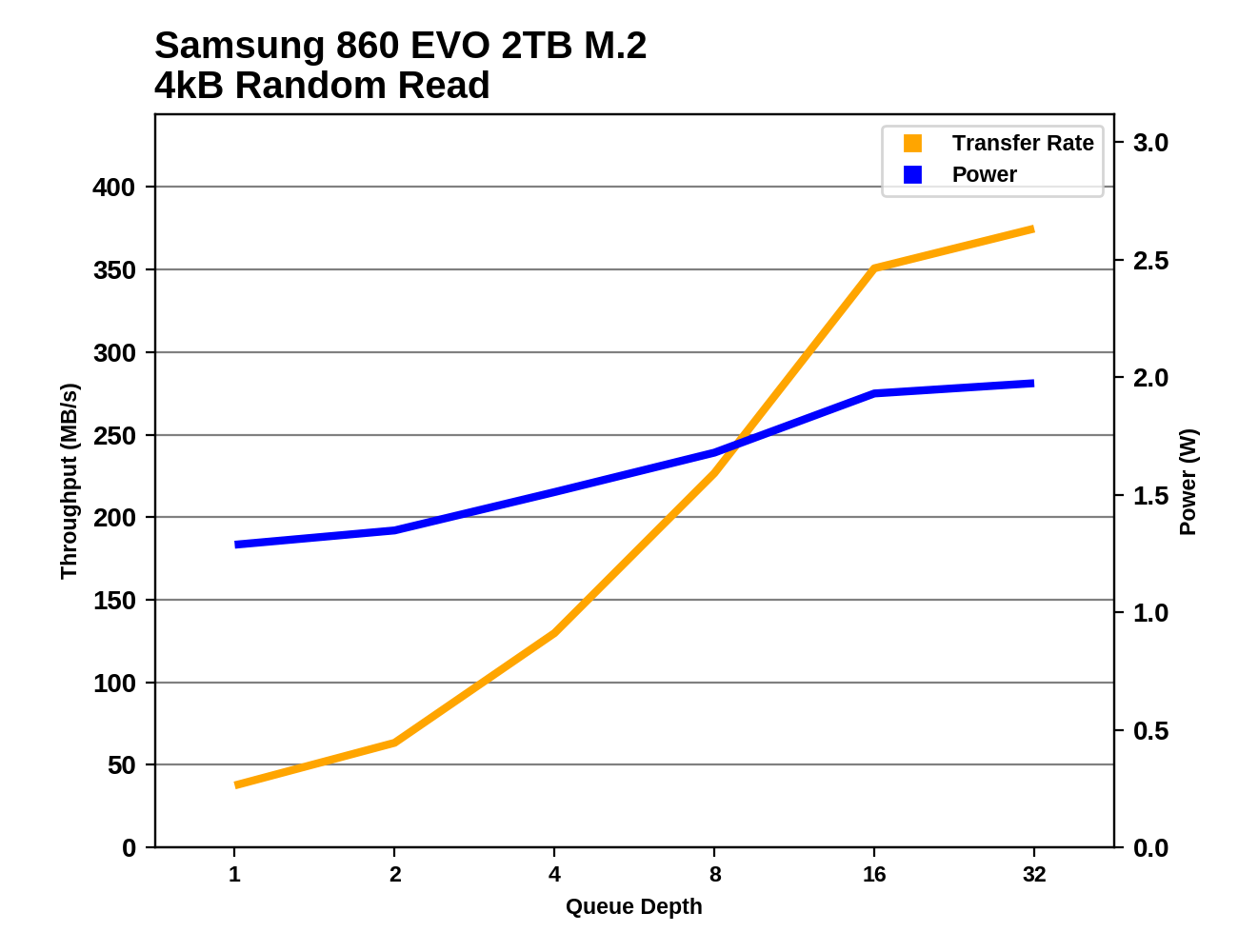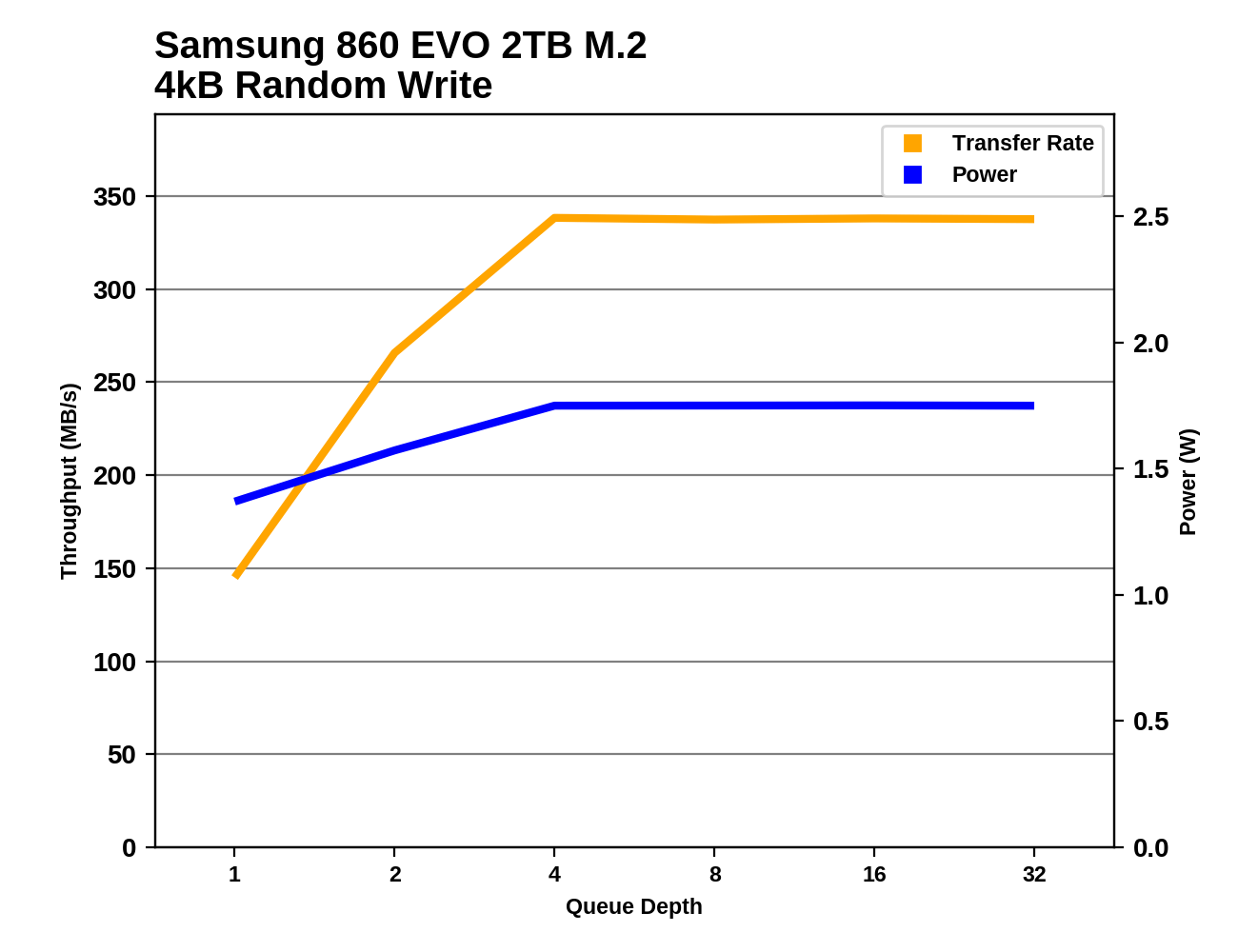The Latest High-Capacity M.2: The Samsung 860 EVO 2TB SSD, Reviewed
by Billy Tallis on February 14, 2018 1:40 PM ESTRandom Read Performance
Our first test of random read performance uses very short bursts of operations issued one at a time with no queuing. The drives are given enough idle time between bursts to yield an overall duty cycle of 20%, so thermal throttling is impossible. Each burst consists of a total of 32MB of 4kB random reads, from a 16GB span of the disk. The total data read is 1GB.

The Samsung 860 EVO's burst random read speed is a bit slower than that of the 850 EVO, and both drives are slower than the fastest competing 3D TLC drives.
Our sustained random read performance is similar to the random read test from our 2015 test suite: queue depths from 1 to 32 are tested, and the average performance and power efficiency across QD1, QD2 and QD4 are reported as the primary scores. Each queue depth is tested for one minute or 32GB of data transferred, whichever is shorter. After each queue depth is tested, the drive is given up to one minute to cool off so that the higher queue depths are unlikely to be affected by accumulated heat build-up. The individual read operations are again 4kB, and cover a 64GB span of the drive.

On the longer random read test with some higher queue depths, Samsung retakes their position of having the fastest TLC drive, though not by a significant margin. The MLC-based 850 PRO and 860 PRO have a substantial advantage.

The power efficiency of the 860 EVO is much better than the 850 EVO, but it's only enough to bring it in line with its current competition. The improvement doesn't even come close to the 860 PRO's impressive boost in efficiency.
 |
|||||||||
The 3D TLC drives in this bunch (with the exception of the outgoing Crucial MX300) all show very similar random read performance scaling as queue depths increase. The Crucial MX500 lags a bit at high queue depths, but all of the current-generation drives top out at about the same speed. The 860 PRO is significantly faster across the entire test while using about the same amount of power.
Random Write Performance
Our test of random write burst performance is structured similarly to the random read burst test, but each burst is only 4MB and the total test length is 128MB. The 4kB random write operations are distributed over a 16GB span of the drive, and the operations are issued one at a time with no queuing.

The burst random write speed of the 860 EVO is improved significantly over the 850 EVO, but Crucial's SLC write caches on the MX300 and MX500 are still faster.
As with the sustained random read test, our sustained 4kB random write test runs for up to one minute or 32GB per queue depth, covering a 64GB span of the drive and giving the drive up to 1 minute of idle time between queue depths to allow for write caches to be flushed and for the drive to cool down.

The sustained random write performance of the Samsung 860 EVO is about the same as the 860 PRO, and is a bit ahead of the competing TLC drives. This is one test where the 1TB models from Crucial and SanDisk appear to be at a disadvantage due to their lower capacities, so a fairer test against the 2TB models of those products would probably show a substantially smaller lead for the 860 EVO.

The 860 EVO's jump in power efficiency is almost as large as the 860 PRO's improvement. This puts the 860 EVO well ahead of the competing TLC SSDs.
 |
|||||||||
Most of these SSDs reach full random write speed at QD4. The 1TB Crucial MX500 is the noticeable outlier with much slower performance growth that doesn't reach full speed until QD16. The 1TB SanDisk Ultra 3D saturates at QD4, but with throughput that is far below the Samsung drives. Even the remarkably power-efficient (for its time) Crucial MX300 uses more power than the 860 EVO, while delivering slightly lower performance.










32 Comments
View All Comments
DanNeely - Wednesday, February 14, 2018 - link
Did you do the performance tests via the sata-m2 adapter too? If so will you be re-running them in PCIe mode next?JanW1 - Wednesday, February 14, 2018 - link
This is a M.2 SATA drive, no point in trying to run tests in PCIe mode.Flunk - Thursday, February 15, 2018 - link
I can already tell you the results, they're all 0.Drazick - Wednesday, February 14, 2018 - link
M.2 is perfect for Laptop's.Why don't we see U.2 for Desktop's?
It will mitigate most throttling issues.
Not to say simplify the Mother Boards.
CheapSushi - Thursday, February 15, 2018 - link
There are U.2 for desktops....But U.2 is NVMe/PCIe based. This is SATA/AHCI. You can turn a mini-SAS port and I think U.2 (correct me if wrong) into a quad SATA port with appropriate cable. Nothing wrong with SATA/AHCI for a bulk storage drive. Unless you'e assuming everyone just wants ONE drive for the entire system.BurntMyBacon - Thursday, February 15, 2018 - link
In a system you would want to use the U.2 port in, there is a decent probability that a second drive will be desired if not already present. Like you said, "Nothing wrong with SATA/AHCI for a bulk storage drive". For systems that you can rule out a bulk storage drive, there is a high probability that nVME needs will be served by M.2 rather than U.2.Though some can tell a difference, it is not even certain that most perceive the performance benefit moving from a fast SATA SSD to an nVME SSD for a primary disk due to how current operating systems handle the storage subsystem.
Bulat Ziganshin - Thursday, February 15, 2018 - link
3dnews.ru testing shown that 512 GB model sometimes is slower than 850EVO, due to lower parallelism. It's why Samsung sent you 2TB model for tests insteadyankeeDDL - Thursday, February 15, 2018 - link
Why was the 960 EVO/PRO not included?SpaceRanger - Thursday, February 15, 2018 - link
Because this is a SATA drive, not an NVME drive.Flunk - Thursday, February 15, 2018 - link
As such they utterly destroy this.